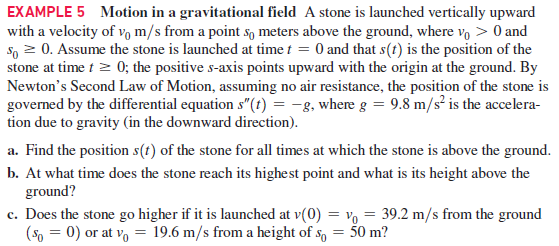EXAMPLE 5 Motion in a gravitational field A stone is launched vertically upward with a velocity of v m/s from a point s, meters above the ground, where vo > 0 and S, 2 0. Assume the stone is launched at time t = 0 and that s(t) is the position of the stone at time t > 0; the positive s-axis points upward with the origin at the ground. By Newton's Second Law of Motion, assuming no air resistance, the position of the stone is governed by the differential equation s"(t) = -8, where g = 9.8 m/s² is the accelera- tion due to gravity (in the downward direction). a. Find the position s(t) of the stone for all times at which the stone is above the ground. b. At what time does the stone reach its highest point and what is its height above the ground? c. Does the stone go higher if it is launched at v(0) = vo = 39.2 m/s from the ground (So = 0) or at vo = 19.6 m/s from a height of so = 50 m?
Suppose the initial conditions in the given example part (a) are ν0 = 14.7 m/s and s0 = 49 m. Write the position function s(t), and state its domain. At what time will the stone reach its maximum height? What is the maximum height at that time?

Suppose the initial conditions in the given example part (a) are ν0 = 14.7 m/s and s0 = 49 m.
To write the position function s(t), and state its domain. At what time will the stone reach its maximum height ? What is the maximum height at that time
Acceleration due to gravity,
Taking the downward direction as negative y-axis.
(a)
Integrating once,
Which is velocity,
[1]
Integrating again,
[2]
Using initial conditions to find the value of the constants c1 and c2.
At t = 0, s0 = 49 m
at t = 0, v0 =14.7 m/s
So, [2] becomes,
[3]
(b)
Velocity at maximum height h is v = 0 m/s
At t = 1.5 s, s(t) = h, from [3],
(c) For v(0) = 39.2 m/s, x(0) = 0 m
Using initial condition in [1],
Using initial condition in [2],
Equation [2] becomes,
At t = 4 s
For v(0) = 19.6 m/s, x(0) = 50 m
Using initial condition in [1],
Using initial condition in [2],
Equation [2] becomes,
At t = 2 s
Yes, the stone goes higher in both the cases.
Trending now
This is a popular solution!
Step by step
Solved in 2 steps









